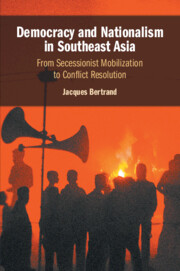Book contents
- Democracy and Nationalism in Southeast Asia
- Democracy and Nationalism in Southeast Asia
- Copyright page
- Dedication
- Contents
- Figures and Tables
- Preface and Acknowledgements
- Abbreviations
- 1 Introduction
- 2 Nationalist Conflict in Democratic Contexts
- 3 Aceh
- 4 Papua
- 5 Moros of Mindanao
- 6 “Exit and Reframe”
- 7 Malay Muslims in Thailand
- 8 Conclusion
- Glossary
- Bibliography
- Index
4 - Papua
Failed Autonomy and Divided They Stand
Published online by Cambridge University Press: 04 May 2021
- Democracy and Nationalism in Southeast Asia
- Democracy and Nationalism in Southeast Asia
- Copyright page
- Dedication
- Contents
- Figures and Tables
- Preface and Acknowledgements
- Abbreviations
- 1 Introduction
- 2 Nationalist Conflict in Democratic Contexts
- 3 Aceh
- 4 Papua
- 5 Moros of Mindanao
- 6 “Exit and Reframe”
- 7 Malay Muslims in Thailand
- 8 Conclusion
- Glossary
- Bibliography
- Index
Summary
The initial period of democratization produced little change in levels of violence, because it had been mostly sporadic, localized, and of low intensity. Aside from occasional larger-scale operations under authoritarian rule, most state violence involved few soldiers in isolated areas, or violent crackdowns on demonstrators in main cities. On the Papuan side, the Free Papua Movement (Organisasi Papua Merdeka, OPM) occasionally attacked military outposts or isolated soldiers. The main change, therefore, was a reduction in large-scale operations, except in border areas.
he absence of large-scale violence can be explained in large part by insurgent groups’ weak organizational capacity and lack of weapons. Furthermore, along with Papuan organizations more broadly, insurgent groups have been strongly divided. The OPM remained composed of divided factions under competing leadership.
- Type
- Chapter
- Information
- Democracy and Nationalism in Southeast AsiaFrom Secessionist Mobilization to Conflict Resolution, pp. 110 - 140Publisher: Cambridge University PressPrint publication year: 2021

